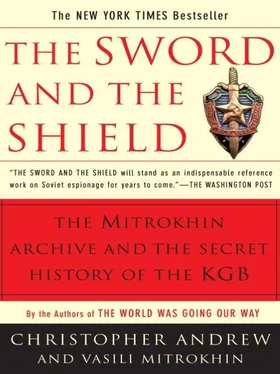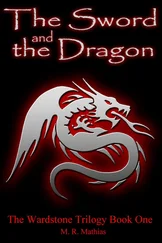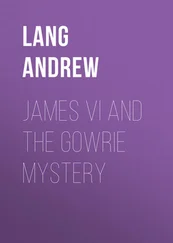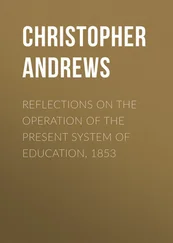As well as initiating an unprecedented series of collaborative histories for publication in the West, the SVR has produced a number of less sophisticated works for the Russian market. In 1995, to mark the seventy-fifth anniversary of the foundation of the Soviet foreign intelligence service, of which it sees itself as the heir, the SVR published a volume on the careers of seventy-five intelligence officers—all, it appears, sans peur et sans reproche— which differs little from the uncritical hagiographies of the KGB era. 68In 1995 the SVR also began the publication of a multi-volume official history of KGB foreign operations which by 1997 had reached the beginning of the Great Patriotic War. 69Though a mine of mostly reliable factual information, it too presents a selective and sanitized view of Soviet intelligence history. It also preserves, in a mercifully diluted form, some of the traditional conspiracy theories of the KGB. The literary editor of the official history, Lolly Zamoysky, was formerly a senior FCD analyst, well known within the Centre and foreign residencies for his belief in a global Masonic-Zionist plot. 70In 1989 he published a volume grandly entitled Behind the Façade of the Masonic Temple, which blamed the Freemasons for, inter alia, the outbreak of the Cold War. 71
The underlying rationale for the SVR’s selection of topics and documents for histories of past operations is to present Soviet foreign intelligence as a dedicated and highly professional service, performing much the same functions as its Western counterparts but, more often than not, winning the contest against them. 72Even under Stalin, foreign intelligence is presented as the victim rather than the perpetrator of the Terror 73—despite the fact that during the later 1930s hunting down “enemies of the people” abroad became its main priority. 74Similarly, the SVR seeks to distance the foreign intelligence operations of the FCD during the Cold War from the abuse of human rights by the domestic KGB. In reality, however, the struggle against “ideological subversion” both at home and abroad was carefully coordinated. The KGB took a central role in the suppression of the Hungarian Uprising in 1956, the crushing of the Prague Spring in 1968, the invasion of Afghanistan in 1979, and the pressure on the Polish regime to destroy Solidarity in 1981. Closely linked to the persecution of dissidents within the Soviet Union were the FCD’s PROGRESS operations against dissidents in the rest of the Soviet Bloc and its constant harassment of those who had taken refuge in the West. 75By the mid-1970s the FCD’s war against ideological subversion extended even to operations against Western Communist leaders who were judged to have deviated from Moscow’s rigid Party line. 76
On these and many other operations, Mitrokhin’s archive contains much material from KGB files which the SVR is still anxious to keep from public view. Unlike the documents selected for declassification by the SVR, none of which are more recent than the early 1960s, his archive covers almost the whole of the Cold War. Most of it is still highly classified in Moscow. The originals of some of the most important documents noted or transcribed by Mitrokhin may no longer exist. In 1989 most of the huge multi-volume file on the dissident Andrei Sakharov, earlier branded “Public Enemy Number One” by Andropov, was destroyed. Soon afterwards, Kryuchkov announced that all files on other dissidents charged under the infamous Article 70 of the criminal code (anti-Soviet agitation and propaganda) were being shredded. 77In a number of cases, Mitrokhin’s notes on them may now be all that survives.
Vasili Mitrokhin has thus made it possible to extend what John Costello praised in 1993 as the “new precedent for openness and objectivity in the study of intelligence history” set by Kryuchkov and his SVR successors far beyond the limits any of them could have envisaged.
TWO
FROM LENIN’S CHEKA TO STALIN’S OGPU
For most of Mitrokhin’s career in the KGB, the history of its domestic operations was something of an embarrassment even to its own historians. During the late 1930s the KGB (then known as the NKVD) had been the chief instrument of Stalin’s Great Terror, the greatest peacetime persecution in European history. The KGB officers club in the Lubyanka, its Moscow headquarters, lacked even the usual boardroom photographs of past chairmen; most were more suited to a chamber of horrors than to a hall of fame. Three had been shot after being found guilty of horrific crimes (some real, others imaginary): Genrikh Yagoda in 1938, Nikolai Yezhov in 1940 and Lavrenti Beria in 1953. A fourth—Ivan Serov—blew his brains out in 1963. KGB historians in the post-Stalin era tended to take refuge from the blood-stained reality of their Stalinist past and homicidal former chairmen by returning to an earlier, mostly mythical, Leninist golden age of revolutionary purity.
The KGB traced its origins to the foundation on December 20, 1917, six weeks after the Bolshevik Revolution, of the Cheka, the first Soviet security and intelligence agency. Throughout Mitrokhin’s career, KGB officers styled themselves Chekists (Chekisty) and were paid their salaries not on the first but on the twentieth of each month (“Chekists’ Day”) in honor of the Cheka’s birthday. The KGB also adopted the Cheka symbols of the sword and the shield: the shield to defend the revolution, the sword to smite its foes. Outside the Lubyanka, the KGB’s Moscow headquarters, stood a huge statue of the Polish-born head of the Cheka, Feliks Dzerzhinsky, venerated in countless official hagiographies as the selfless, incorruptible “Knight of the Revolution” who slew the dragon of counter-revolution which threatened the young Soviet state. He had been a professional revolutionary for over twenty years before the Revolution, spending eleven of those years in Tsarist prisons, penal servitude or exile. KGB training manuals quoted his description of the Chekist as a man with “a warm heart, a cool head and clean hands.” Like Lenin, he was an incorruptible workaholic, prepared to sacrifice both himself and others in the defense of the Revolution. 1In the headquarters of the KGB First Chief (Foreign Intelligence) Directorate at Yasenevo, the main object of veneration was a large bust of Dzerzhinsky on a marble pedestal constantly surrounded by fresh flowers.
The KGB’s effusive public tributes to its saintly founding father concealed the degree to which Dzerzhinsky derived his intelligence tradecraft from the Cheka’s much smaller Tsarist predecessor, the Okhrana. The Bolsheviks had extensive first-hand experience of the Okhrana’s expertise in the use of penetration agents and agents provocateurs. In July 1913 Lenin had discussed the difficult problem of Okhrana penetration with two of his chief lieutenants, Lev Kamenev and Grigori Zinovyev, and the leader of the Bolshevik deputies in the Duma, Roman Malinovsky. All were agreed that there must be an unidentified Okhrana agent in close contact with the Bolshevik deputies. The agent was in even closer contact than Lenin realized. It was Roman Malinovsky. After Okhrana files later revealed his identity, he was shot in the Kremlin gardens on the first anniversary of the Bolshevik Revolution. 2
The Cheka’s success in penetrating its opponents derived in large part from its imitation of the techniques employed by Malinovsky and other Tsarist agents. Dmitri Gavrilovich Yevseyev, the author of two of the Cheka’s earliest operational manuals, Basic Tenets of Intelligence and Brief Instructions for the Cheka on How to Conduct Intelligence, based his writings on detailed study of Okhrana tradecraft. Though the Cheka was “an organ for building the dictatorship of the proletariat,” Yevseyev insisted—like Dzerzhinsky—that it must not hesitate to learn from the experience of “bourgeois” intelligence agencies. 3
Читать дальше











